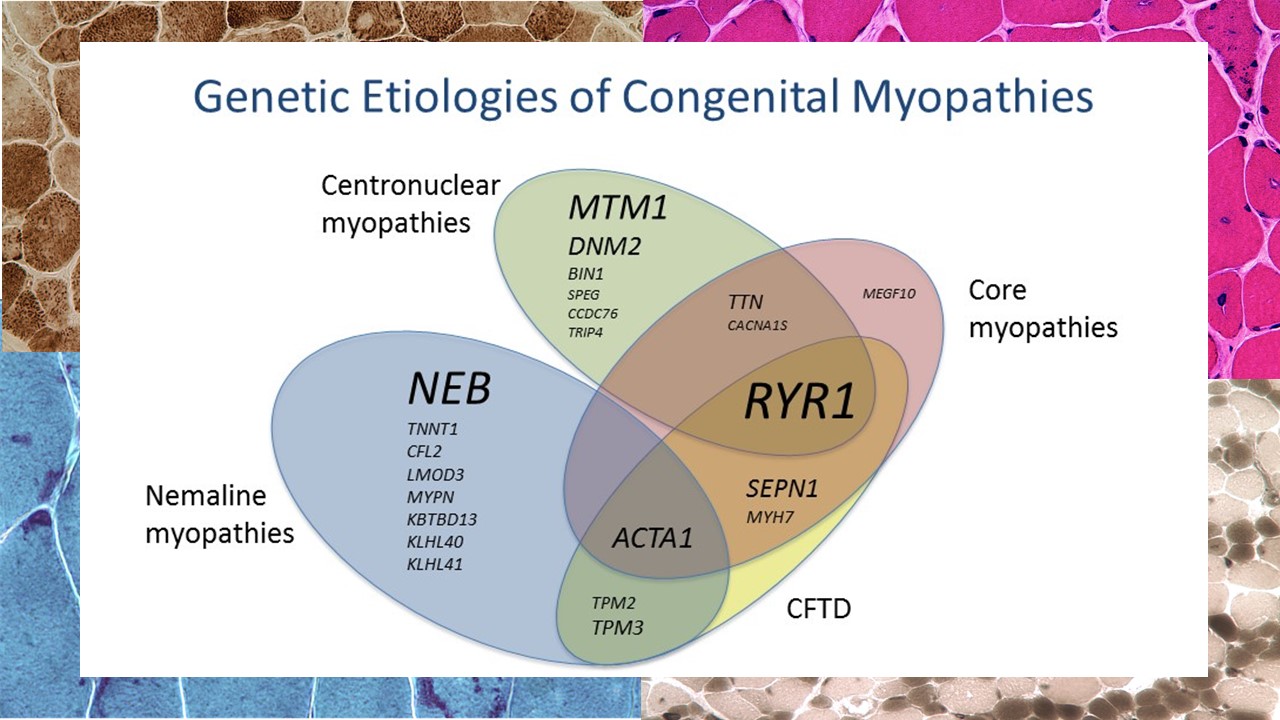The Myopathies | Overview
The "myopathies" is the name given to a group of neuromuscular disorders that affect skeletal muscle, causing generalized muscular weakness among other symptoms. Literally, the word myopathy means "disease of the muscle" (myo=muscle; Gr. pathos=disease). Other types of myopathies are the inflammatory myopathies, the channelopathies, the metabolic myopathies, the mitochondrial myopathies, the dystrophic myopathies, and the non-dystrophic myopathies. Although all these myopathies affect skeletal muscle, the mechanisms that cause disease are different in each type.

The congenital myopathies are a sub-group of neuromuscular conditions that affect skeletal muscle. This group of disorders are often, but not always, present at birth. Hence the name congenital myopathies.
The congenital myopathies are similar in nature, often causing muscle weakness and low muscle tone of varying degrees. Diagnosis is usually made from a muscle biopsy. In these, specific myopathic findings such as nemaline rods or central cores can be observed. These findings allow determination of the type of congenital myopathy that is present.The congenital myopathies are a sub-group of neuromuscular conditions that affect skeletal muscle. This group of disorders are often, but not always, present at birth. Hence the name congenital myopathies.
In the Beggs laboratory, we focus on a group of non-dystrophic myopathies, known as the congenital myopathies because they are often present from birth. Individuals who have a congenital myopathy often have slowly or non-progressive muscular disorders characterized by hypotonia (low muscle tone) and muscle weakness. Sometimes, there are multiple affected family members within a family. Therefore, it is thought that the congenital myopathies are genetic. Genetic conditions are those that arise from gene changes. We are trying to identify and study the genes and proteins involved in the causes of:
-
Non-Specific Congenital Myopathies (for which an established diagnosis has not been made)
By clicking on the links above, you will be taken to general information as well as a description of our research studies on each disease.
The congenital myopathies are similar in nature as they all cause low muscle tone and weakness. However, when muscle tissue samples from patients with different types of congenital myopathies are examined under the microscope, more differences can be observed. Thus, the diagnosis is usually made by the appearance of a muscle sample under the microscope. These studies, also known as "histochemical analyses", make it possible to distinguish between each type of congenital myopathy. While histochemical studies are very useful in establishing a diagnosis, they usually do not tell the actual genetic change that underlies the disorder.
Although the congenital myopathies are often clinically similar, there is a wide spectrum of variability within each. In other words, not everybody will have the same medical issues. Some patients with certain types may not survive past the first few years of life, while others may walk independently through adulthood and have families of their own. If you are interested in obtaining clinical information about any of the congenital myopathies, you may want to contact Dr. Susan Iannaccone, a pediatric neurologist who has been involved in the care of many patients with these disorders.
As mentioned earlier, most congenital myopathies are thought to have a genetic cause. This means that these disorders are often caused by alterations in genes that play a role in muscle function and/or development. A gene is a portion of DNA that harbors a specific instruction for the body. We inherit our genes from our parents and we pass them on to our children.
It is an interesting fact that frequently, the congenital myopathies occur in families where there is no previous history of neuromuscular disorders. In these instances, we say the disorder is "sporadic". Sporadic conditions happen when a genetic change suddenly appears in an individual, causing disease. Although genetic changes can arise sporadically, once the change appears in an individual, there is a possibility that the individual can pass the alteration to his/her children. One of our goals is to detect and understand how these alterations arise and how they are inherited.
This page was last updated October 23, 2020.
